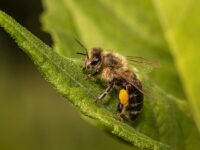Helianthus annuus, commonly known as sunflowers, were named for their tendency to turn towards the sun throughout the day, almost as if they’re sentient. This phenomenon, known as heliotropism, is not unique to sunflowers; most species of legumes also turn towards the sun. However, since the head of the sunflower is so prominent that you can always tell which way it is facing, it is a common subject in studies of heliotropism. Predictably, plants face the sun to optimize light capture — but how do plants “know” where the sun is?
Plants face the sun to optimize light capture — but how do plants “know” where the sun is?
In many heliotropic plants, including the sunflower, the turning is caused by a structure called the pulvinus, located at the point where the leaf connects to the stem. The pulvinus can become more or less rigid based on the pressure of water on the cell walls, also known as turgor pressure. As this change in pressure alters the rigidity of the pulvinus, the whole leaf moves.
This solar tracking behavior may seem simple at first glance; plants benefit from light from the sun, so they face towards it. However, there is still a lot of missing information regarding this phenomenon. At night, sunflowers have been observed to reorient themselves eastward in anticipation of the sunrise. If sunflowers simply direct themselves toward the sun, then how do they know which way to face at night? Also, how does the direction of sunlight indicate the change in turgor pressure that causes the leaves to turn?
What have we learned from experiments?
An experiment from the 1890s sought to uncover which part of the sunflower is responsible for its heliotropic behavior. It was discovered that cutting off the flowering head did not prevent solar tracking, but removing the leaf blades stopped this behavior entirely. A review paper by Vandenbrink et al. remarked that “these results do not distinguish whether the mature leaves function as the location of light reception, the source of a diffusible signal, and/or the source of energy to support the movement.” This experiment was one of the earliest recorded experiments on sunflowers and led to many more studies focused on uncovering the mechanisms behind heliotropism.
Plants may seem like simple, immobile organisms, but in reality they move as though there is conscious planning involved.
Sunflowers have a circadian rhythm, just as humans do. In one study, sunflowers were turned 180 degrees at night to see if they would adjust to the new pattern of sun movement. The sunflowers maintained their original movement patterns for several days before they adapted to their new positions and reoriented to once again track the sun. This showed that following the sun during the day is a trained behavior, and that sunflowers become accustomed to a certain cycle. Just like human sleep cycles, it can take days (or weeks) to adjust to a new one.
The mechanisms by which plants alter water uptake within the pulvinus are not fully understood. One study found that increased sunlight on one side of a plant led to increased acidity in the surrounding tissue. This acidity led to more flexibility in the cell walls of the illuminated side, which coincided with stem bending. There have also been molecules identified to be involved in solar tracking. Auxin, a type of plant hormone, has been found in different concentrations between the illuminated and shaded sides of a plant and correlated with different growth rates in each side. Another type of plant hormone, gibberellin, has also been found in different quantities between the illuminated and shaded parts.
Research on sunflowers has come a long way since 1890. Much remains to be discovered, and sunflowers are just one of many plants that exhibit heliotropism. Plants may seem like simple, immobile organisms, but in reality they move as though there is conscious planning involved. Clearly, plants are more complex and intelligent than we give them credit for.
Image Source: Pixabay






